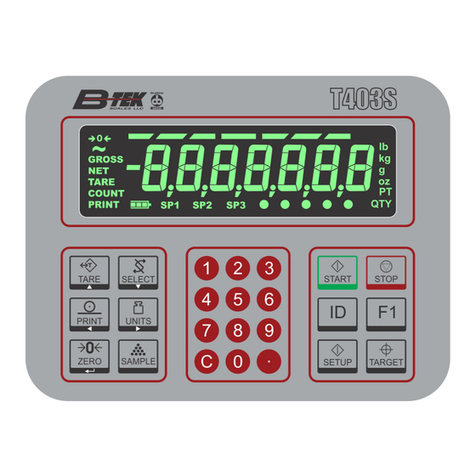
4 T405S Indicator Service Manual
Diag menu ....................................................................................................................... 31
Scale ......................................................................................................................... 32
Current Zero ............................................................................................................. 32
Display ...................................................................................................................... 33
Buttons ...................................................................................................................... 33
Ports ..........................................................................................................................33
Inputs ........................................................................................................................ 34
Outputs ...................................................................................................................... 34
Options ...................................................................................................................... 35
Logs .......................................................................................................................... 35
BSQ ...........................................................................................................................36
Chapter 6 ADMIN level menus ................................................................................................................ 37
Setup menu .....................................................................................................................37
Calibration Procedure ...................................................................................................... 38
Scale 1-2 ................................................................................................................... 38
Zero Procedure ......................................................................................................... 39
Span Procedure ........................................................................................................ 40
Linearity Procedure ................................................................................................... 40
Input procedure ......................................................................................................... 41
Gravity Factor Procedure .......................................................................................... 42
Display ...................................................................................................................... 43
Calibration Unit .......................................................................................................... 43
Print calibration report ............................................................................................... 43
Scale ................................................................................................................................ 44
Scale 1-2 ................................................................................................................... 45
Capacity .................................................................................................................... 45
Division ...................................................................................................................... 45
Units ..........................................................................................................................46
Stable ........................................................................................................................ 47
AZT ...........................................................................................................................47
Filter .......................................................................................................................... 48
Ranges ...................................................................................................................... 49
2,3,Range .................................................................................................................. 50
Type .......................................................................................................................... 51
ROC .......................................................................................................................... 52
System ............................................................................................................................. 53
Default Values ........................................................................................................... 54
Site ............................................................................................................................ 55
Display ...................................................................................................................... 55
Buttons ...................................................................................................................... 56
Display values ........................................................................................................... 56
Tare ...........................................................................................................................59
Config ........................................................................................................................ 60
Archive ...................................................................................................................... 60
Serial .........................................................................................................................61
Update ....................................................................................................................... 61
Password .................................................................................................................. 62
Z-Lock ....................................................................................................................... 62
Beeper ....................................................................................................................... 63
Number of Scales ...................................................................................................... 63
Ports ................................................................................................................................ 64
Serial .........................................................................................................................65
Ethernet ..................................................................................................................... 66
Protocol ..................................................................................................................... 69
P.F.Edit ..................................................................................................................... 72
PLC ...........................................................................................................................72




























